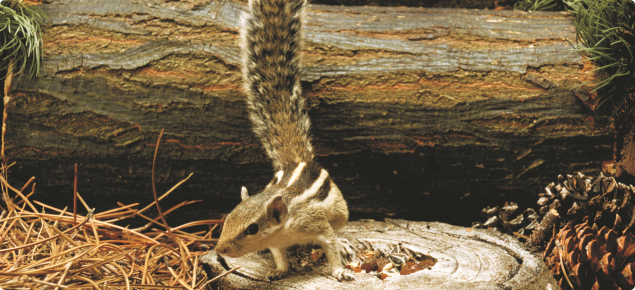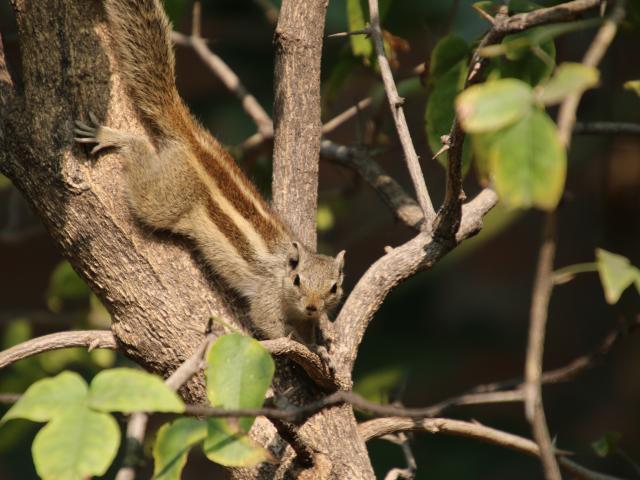Introduction
The northern palm squirrel (Funambulus pennantii) belongs to the order of Rodentia and is a rodent pest of fruit, vegetable and grain crops. It is native to tropical and subtropical regions of northern India where it lives in woodlands and urban areas in cities, villages and small towns.
The species was released in the grounds of Perth Zoo in 1898 for reasons of enhancement and it successfully established a population there. Although the palm squirrel remained confined to this area for many years it eventually dispersed naturally and with human help to a 30 km2 area surrounding the zoo. Some squirrels were occasionally found away from this area but were captured and removed.
The palm squirrel is now considered eradicated in Western Australia and currently there are no known populations of palm squirrels anywhere in Australia. Historically the northern palm squirrel has been detected in the illegal pet trade in Australia and illegal keeping poses the greatest risk of this species again establishing here. Once palm squirrel populations establish they are extremely costly and difficult to remove.
Identification
Northern palm squirrels weigh 60-180g, a bit less than the introduced black rat’s (Rattus rattus) 95-340g. The bushy tail of the palm squirrel, a bit shorter in length than the body, is interspersed with long white and black hairs. The palm squirrel’s back is a grizzled grey-brown colour with five conspicuous white stripes, the reason it is also known as the five-striped palm squirrel. Three of the stripes run from head to tail while the outer two run from the forelegs to the hind legs. The belly is creamy white and the ears small and triangular.
Behaviour, habitat and food
Although the northern palm squirrel lives in tropical and subtropical habitats it is very adaptable and can live in close association with humans in highly modified habitats. It is semi-terrestrial living mainly in trees and above ground structures, it is also very gregarious and is often found in small groups of up to 10 individuals.
The northern palm squirrel is most active in the morning and early evening having a rapid darting movement and great agility when climbing. Unlike other squirrels, northern palm squirrels do not hibernate in winter, but rather only emerge in the late afternoon of sunny days. The female palm squirrel builds a nest of sticks and plant material in tree cavities or on branches and cavities in house walls and windowsills. Baby palm squirrels mature at 6-9 months of age.
The pest and its impacts
In Australia the northern palm squirrel is listed as an extreme threat species nationally and in Western Australia it is a declared pest under the Biosecurity and Agriculture Management Act 2007 due to this listing.
The northern palm squirrel is a serious pest of orchard fruits such as pineapple, mango, pomegranate, apples, guava, blackberries and grapes. Extensive damage occurs in orchards, gardens and public parks as the squirrel forages for seeds, fruits, nuts, plant stems, young bark, buds, leaves, flowers, nectar, insects and grubs. Vine and fruit crops and market gardens close to the city are at risk from damage. Sugarcane and groundnut crops such as peanuts also suffer damage. The palm squirrel is also a scavenger, eating food wastes and human-edible food like school children’s lunches. It can also damage electrical wiring in houses creating a fire risk.
Introduced populations pose a risk to Australian native species susceptible to competition with the palm squirrel for breeding sites and food. Bird eggs and nestlings are at risk from direct predation, and this could result in a reduction of bird biodiversity in city parks and gardens.
Native species that could be mistaken for the northern palm squirrel
- Common Brushtail Possum (throughout Australia)
- Brush-tailed Phascogale (northern, eastern, and south-western Australia)
- Gliders, such as the Yellow-bellied Glider, Sugar Glider or Squirrel Glider (northern and eastern Australia)
- Numbat (isolated populations in south-western Australia)
How to report
If you see an animal which might be a northern palm squirrel, note the date, time and location of the pest. Take photographs, if possible and report to the Pest and Disease Information Service using MyPestGuide® Reporter via app or online at mypestguide.agric.wa.gov.au, telephone (08) 9368 3080 or email padis@dpird.wa.gov.au


